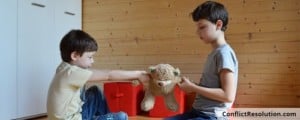
By Michael Grose | Submitted On January 13, 2005
Teaching kids to deal with conflict effectively and peacefully is perhaps the biggest challenge facing adults today. Children’s disagreements both at home and at school can be noisy, physical and psychologically hurtful. The approach to conflict resolution learned and practised in childhood often stays for life.
Conflict is part of daily living. Effective people resolve conflict in ways that protect relationships, honour feelings and lead to a resolution. They neither avoid conflict nor do they use power to dominate others or win conflict.
It is useful for parents to provide a process for children to resolve individual differences peacefully and effectively. When two children have a disagreement that is upsetting to one or either then they may need adult assistance to resolve the conflict. One process that is both easy to learn and highly effective is the Face-Up conflict resolution process that is a variation on some common processes in use.
In the Face-up process children face each other and maintain eye contact. This helps for greater openness and understanding. It generally requires an adult to be present as a third party so parents may need to stick around to make sure it works effectively.
The steps involved in the Face-up process:
1. Safety first: To ensure safety and integrity it is important that both children are calm. Give them time and some help to regain control if they are angry or upset.
2. Feelings second: Using I-messages children tell each other how they feel about the situation. “I feel awful when you don’t share your toys. I really feel like losing it because it is not fair.” Focus on the feelings and don’t let it get into recriminations or accusations.
3. Repeat third: Sometimes this process is enough to get a resolution or at least an apology. Repeat this procedure if necessary so both children feel they have been heard.
4. Resolve fourth: State the problem as you see it or as children identify it. Sometimes children just want to state their case and they will make their own suggestion about resolving it. “You can play with my old toys but I don’t want you playing with my new toys for a while. They’re special.” “Okay.”
5. Make-up fifth: An apology or an agreement is often enough however sometimes damage may need to be repaired or a follow-up talk from a parent about better behaviour may be appropriate.
Teaching children some simple rules for resolving conflict and a process such as the one above may well be one of the best investments in time and energy that a parent will make.
—
Article Information
Michael Grose is Australia’s leading parenting educator. He is the author of six books and gives over 100 presentations a year and appears regularly on television, radio and in print.
For further ideas to help you raise happy children and resilient teenagers visit http://www.parentingideas.com.au. While you are there subscribe to Happy Kids newsletter and receive a free report Seven ways to beat sibling rivalry.
Article Source: http://EzineArticles.com/?expert=Michael_Grose


